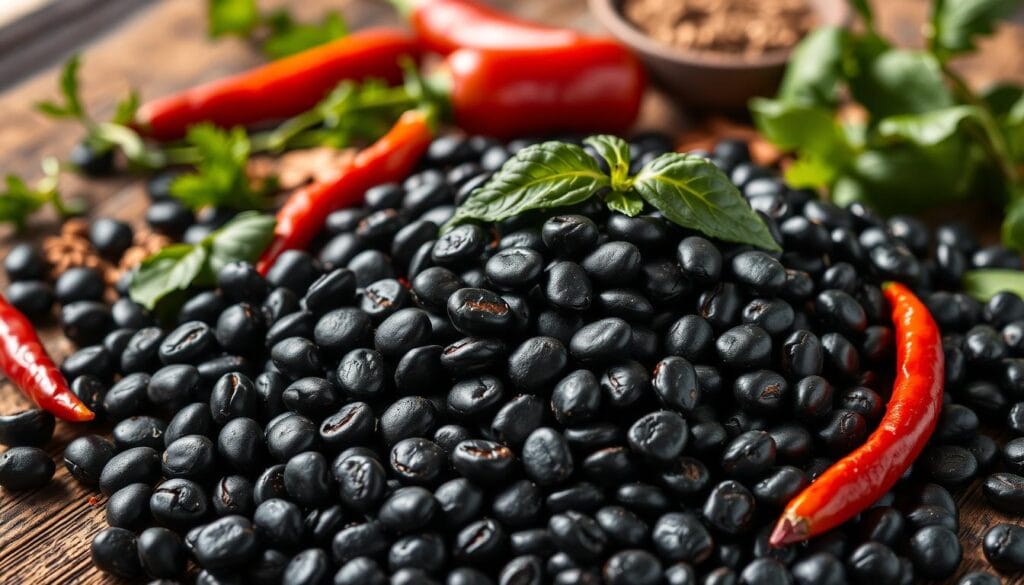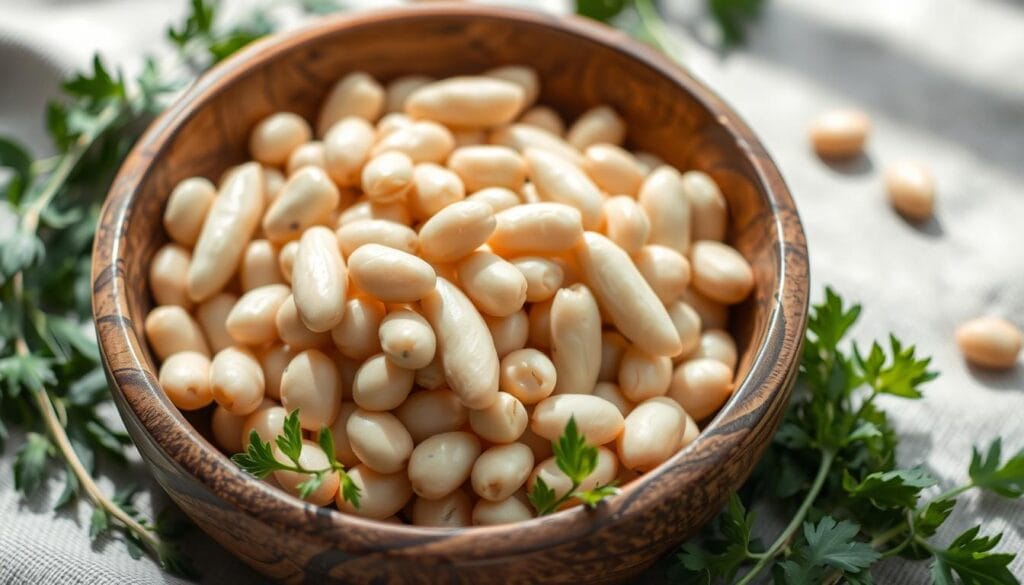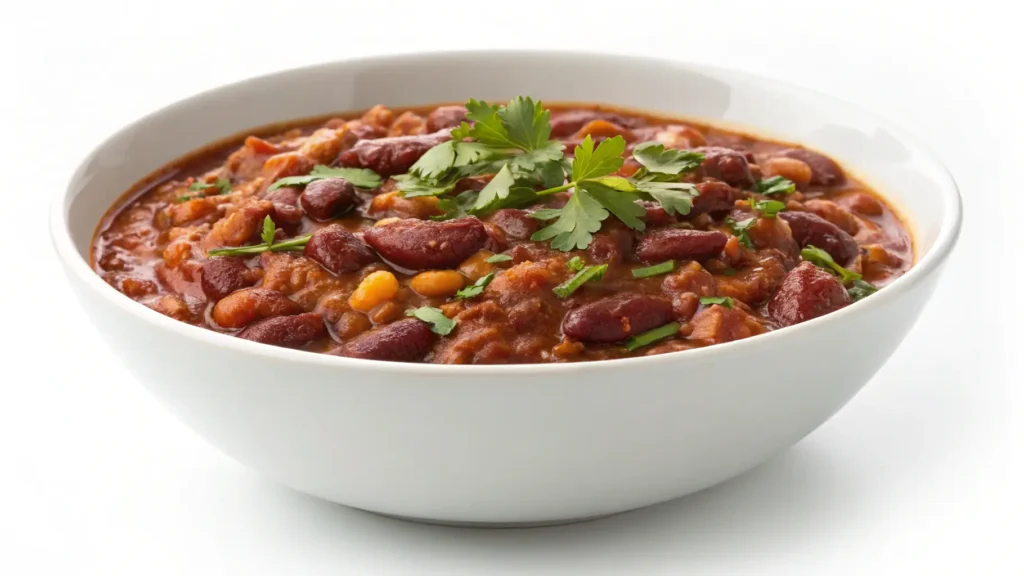When chili simmers, it brings back cozy nights and fun gatherings. A warm bowl of chili is the ultimate comfort. It’s a mix of savory, spicy, and satisfying flavors. Beans are at the core, each adding its own texture and taste.
Whether you love chili or are new to it, knowing the best beans is crucial. From red kidney beans to black beans, each type brings something special. Let’s explore how to make your chili the best it can be.
Table of Contents
Understanding the Role of Beans in Chili Making
Beans are key in chili, adding texture and flavor. There are many beans for chili, each with its own traits. From kidney bean to black bean, the options are endless.
Texture and Flavor Balance
The beans you pick change your chili’s texture and flavor. Pinto beans make it creamy, thickening it. Cannellini beans give a tender feel.
Nutritional Benefits
Beans are also nutritious. They’re full of protein, fiber, and important vitamins and minerals. Using different beans in your chili boosts its health value.
Cooking Time Considerations
The cooking time for beans affects your chili. Kidney beans take longer to soften. Canned beans cook quickly.
| Bean Variety | Texture | Flavor | Cooking Time |
|---|---|---|---|
| Kidney Beans | Firm, creamy | Rich, earthy | 60-90 minutes |
| Black Beans | Meaty, dense | Robust, savory | 45-60 minutes |
| Pinto Beans | Creamy, soft | Mild, slightly sweet | 60-90 minutes |
| Cannellini Beans | Tender, delicate | Nutty, mild | 45-60 minutes |
Knowing about bean varieties helps you make the best chili. It balances texture, flavor, and nutritional benefits perfectly.
Best Beans for Chili: Essential Varieties for Perfect Results
Choosing the right beans is key to making great chili. The most popular beans for chili are kidney beans, black beans, pinto beans, and cannellini beans. Each type brings something special to your chili.
Kidney Beans: Kidney beans are a top pick for chili. They keep their shape well and have a meaty texture. Their bold flavor adds depth to the dish.
Black Beans: Black beans are a great choice for chili. They have a meaty texture and add complexity to the dish. Their earthy taste goes well with chili spices.
- Black beans stay firm even after long cooking times.
- Their earthy, sweet taste complements chili spices well.
Pinto Beans: Pinto beans are known for their creamy texture. They have a mild flavor that lets other chili ingredients shine. They add a satisfying feel to the dish.
- Add pinto beans towards the end of cooking to keep them creamy.
- They soak up flavors well, making them versatile in chili.
Cannellini Beans: Also called white kidney beans, cannellini beans are a great choice. They have a similar texture to kidney beans but with a nuttier taste. This adds a unique flavor to your chili.
When picking beans for your chili, think about how they’ll affect the dish’s texture and taste. Try different beans to find the perfect mix for your taste and recipe.
Kidney Beans: The Classic Choice
Kidney beans are a classic choice for the perfect chili. They have a distinct flavor and texture that many love. Their thick skins and creamy interiors make them great for long cooking times.
Red Kidney Bean Properties
Red kidney beans add a sweet and earthy taste to chili. Their strong flavor goes well with chili’s bold spices. As they cook, they soak up all the flavors, making the dish taste amazing.
Cooking Tips for Kidney Beans
- Soak the kidney beans overnight or use the quick-soak method to ensure they cook evenly.
- Add the soaked beans to the chili during the initial stages of cooking to allow ample time for the flavors to meld.
- Adjust the cooking time as needed to achieve the desired texture, as kidney beans can take longer to tenderize compared to other bean varieties.
Texture and Flavor Profile
When cooked right, kidney beans add a great texture to chili. They’re creamy and slightly chewy. Their earthy and sweet flavors blend well with the spices and other ingredients.
“Kidney beans are the quintessential choice for a classic, hearty chili. Their robust flavor and ability to absorb the chili’s spices make them an essential ingredient in any true chili enthusiast’s repertoire.”
Black Beans: Rich and Meaty Alternative
Black beans are a key ingredient in a tasty chili. They have a rich, meaty texture that goes well with spices. Unlike kidney beans, black beans are smaller but have a big flavor.
Black beans keep their shape well when cooked. They have a mild taste, letting other flavors stand out. They also add protein and fiber to your meal.
Black beans are great for any chili, whether it’s beef or vegetarian. They offer a perfect mix of texture and taste.
| Ingredient | Quantity | Nutritional Value (per serving) |
|---|---|---|
| Black Beans | 2 14-ounce cans | Calories: 433, Protein: 25g, Fiber: 14g |
| Lean Ground Beef | 1 pound | Calories: 433, Protein: 25g, Fat: 21g |
| Tomatoes | 1 28-ounce can | Calories: 433, Vitamin C: 41mg, Potassium: 1327mg |
Black beans, lean ground beef, and tomatoes make a meaty texture and rich flavor. Try different spices and toppings to make it your own.

“Black beans are a game-changer in chili recipes, providing a satisfying and nutritious foundation for your dish.”
Pinto Beans: Creamy Texture Champion
Pinto beans are the top choice for a tasty and cozy chili. They have a creamy texture that thickens the chili and feels great in your mouth. Their mild, slightly sweet taste is perfect for soaking up all the chili’s spices and seasonings.
Preparation Methods
To get the most out of your pinto beans, proper preparation is essential. Start by soaking the dried beans overnight. This makes them cook faster and easier to digest. Then, simmer the beans for 1 hour 15 minutes to 3 hours 45 minutes, depending on how tender you like them.
Adding a pinch of baking soda to the water can make the beans even creamier. This helps break down their cell walls.
Flavor Enhancement Tips
Pinto beans are great at taking on flavors, so season them well. Mix in chili powder, cumin, garlic, and onions as they cook. Adding a bit of maple syrup or brown sugar towards the end can also bring out their natural sweetness.
With their ability to absorb all the delicious flavors, pinto beans are the creamy texture champion for your next chili.
| Pinto Bean Nutrition Facts (per serving) | Amount | % Daily Value |
|---|---|---|
| Calories | 194 | – |
| Carbohydrates | 34g | 11% |
| Protein | 19.7g | 39.4% |
| Fat | 8g | 12% |
| Fiber | 11g | 39% |
| Sodium | 1123.4mg | 46.8% |
Cannellini Beans: The White Bean Option
Choosing the right beans can change your chili’s flavor and texture. Cannellini beans, also known as white kidney beans, are a tasty choice. They have a mild, nutty taste and a creamy texture that contrasts well with the usual chili colors.
Cannellini beans keep their shape well when cooked, making them great for chili. They’re sturdy, so they don’t break down easily. This adds a hearty bite to your chili. Their creaminess also balances out the strong chili spices, making the dish smooth and flavorful.
For those looking to mix things up, cannellini beans are a great option. You can use them alone or mix them with other beans like kidney or pinto. They’re a versatile choice that can add a new twist to your chili.
| Nutritional Information (per serving) | Value |
|---|---|
| Calories | 479 |
| Fat | 8.0 g (12.3%) |
| Saturated Fat | 1.4 g (7.2%) |
| Carbohydrates | 79.0 g (26.3%) |
| Fiber | 16.3 g (65.3%) |
| Sugars | 6.2 g |
| Protein | 26.7 g (53.3%) |
| Sodium | 1321.8 mg (55.1%) |
To use cannellini beans in your chili, follow these tips:
- Choose canned cannellini beans for ease, or cook dried beans that have been soaked.
- Add the cannellini beans towards the end of cooking to keep their texture.
- Try different seasonings and spices to match the cannellini beans‘ mild flavor.
- Combine cannellini beans with other beans for a more varied and tasty chili.
“Cannellini beans add a creamy, nutty flavor that perfectly complements the robust spices in chili. They’re a must-try for anyone looking to switch up their traditional chili recipe.”
Adding cannellini beans to your chili can give it a unique twist. Whether you make a white bean chili or mix them with other beans, they’re sure to impress. These versatile beans will add a new dimension to your chili-making adventures.

Combining Different Bean Types
Creating the perfect chili involves trying out different bean combinations. Mixing various beans can elevate your dish’s flavor. It makes the chili more complex, balanced, and satisfying.
Complementary Bean Pairings
Some classic bean pairings in chili include:
- Kidney beans and pinto beans: Their firm and creamy textures complement each other well.
- Black beans and kidney beans: The earthy flavor of black beans pairs nicely with kidney beans’ sweetness.
- Cannellini beans and chickpeas: These two create a harmonious blend with their nutty and creamy flavors.
Multi-Bean Chili Recipes
For a dynamic chili experience, try using three or more bean varieties. This adds complexity to the texture and flavor. Here are some delicious multi-bean chili recipes:
- Three-Bean Chili: A hearty mix of kidney beans, black beans, and pinto beans.
- White Bean Chicken Chili: A creamy blend of cannellini beans, great northern beans, and chicken.
- Fiesta Chili: A vibrant mix of red kidney beans, black beans, and adzuki beans, topped with fresh garnishes.
When using different beans, remember their cooking times. Add them to the pot in the right order. This ensures each bean is cooked perfectly and adds its unique flavor and texture.

Beans to Avoid in Your Chili
Choosing the right beans is key to a great chili. Kidney, black, and pinto beans are favorites, but some beans don’t belong. Knowing which ones to avoid helps you get the flavor and texture just right.
Why Some Beans Don’t Work
Lima, garbanzo, and fava beans aren’t ideal for chili. They have unique tastes and textures that don’t mix well with chili’s bold flavors. For example, lima beans can be starchy, and garbanzo beans (chickpeas) can be grainy.
Common Bean Mistakes
One mistake is overcooking beans, making them mushy. Also, getting the bean-to-liquid ratio wrong can mess up your chili’s consistency. It’s crucial to pick beans that match your chili’s flavor, as some don’t go well with common spices.
Conclusion:
Choosing the best beans for chili is more than just a culinary decision—it’s the key to unlocking the rich, comforting, and complex flavors that make chili a beloved dish around the world. From the hearty texture of kidney beans to the creamy richness of pinto beans, each variety offers something unique that can elevate your recipe to new heights. The right combination of beans not only enhances texture and flavor but also adds nutritional value, making your chili as wholesome as it is delicious.
As you embark on your chili-making journey, don’t be afraid to experiment. Mix and match kidney, black, pinto, and cannellini beans to discover your perfect flavor profile. Whether you’re preparing a classic chili con carne, a vegetarian delight, or a creative multi-bean masterpiece, the possibilities are endless. Remember, the secret lies in balancing textures, embracing bold spices, and using cooking techniques that allow the beans to shine.
And while selecting the best beans is crucial, avoiding common pitfalls—like overcooking or using beans that clash with chili’s bold flavors—can make all the difference. Approach your recipe with care, creativity, and a willingness to try new things.
So, grab your pot, gather your favorite beans, and let your kitchen fill with the tantalizing aroma of chili simmering to perfection. Whether it’s a cozy family dinner or a festive gathering with friends, your chili will be a heartwarming dish that leaves everyone coming back for seconds. The perfect beans are out there waiting for you—start cooking and create your ultimate bowl of comfort today!
FAQ
What are the best bean varieties for chili?
How do different beans contribute to the texture and flavor of chili?
What are the nutritional benefits of using beans in chili?
How do cooking times and preparation methods affect the performance of beans in chili?
Are there any bean varieties that may not work well in chili?
Have you tried our Recipe ?
There are no reviews yet. Be the first one to write one.


1 thought on “Best Beans for Chili: Top Choices for Flavorful Recipes”
Comments are closed.